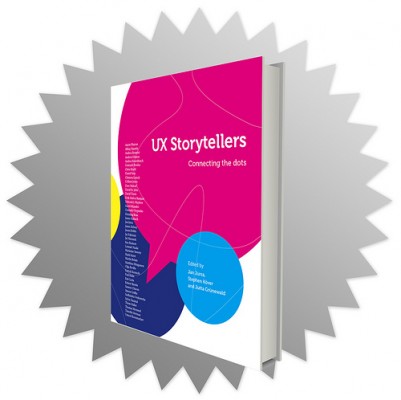Archives for November 2010
Prezentacja – Understanding the Everyday Use of Images on the Web
UX Storytellers – dobra książka za darmo!
 Wczoraj późnym wieczorem ukazała się w formie darmowego eBooka książka, na którą od jakiegoś czasu “ostrzyłem sobie zęby”, oglądając kolejne wpisy autorów bloga UX Storytellers.
Wczoraj późnym wieczorem ukazała się w formie darmowego eBooka książka, na którą od jakiegoś czasu “ostrzyłem sobie zęby”, oglądając kolejne wpisy autorów bloga UX Storytellers.
Jaka myśl przewodnia stała za stworzeniem tej książki?
Does this situation seem familiar to you? … You’re at a conference or a party or another occasion, you’re talking IA and UX and suddenly someone tells a remarkable story. You and your pals either laugh or shudder; perhaps the story made your skin crawl. Days later, when you think back, your hair stands on end, and every time you face a certain situation, you remember what you learned through this particular story.
At UX Storytellers, we want to collect those stories and publish them here on this blog, as a free PDF, an online magazine and as a book (translated into various languages).
Książkę zdecydowanie polecam – jest do ściągnięcia lokalnie (16 MB PDF) i na stronie autorów via Scribd. Warto!
Wyrwane z kontekstu – Social Skills for UX Consultants
W najnowszym User Experience warty uwagi artykuł Social Skills for UX Consultants -Communication on the Job. Tradycyjnie – wyrwana z kontekstu najciekawsza myśl:
Use a Guerrilla Communication Strategy to Overcome Information Entropy
Problem: Three weeks ago, the project manager decided to abandon the use of AJAX components because of security considerations. In the meantime, the UX consultant was preparing a supplementary document for the user interface style guide, describing the specifications of the AJAX UI-controls. In the next status meeting the UX consultant hears that the supplementary document will no longer be necessary. Two weeks of work for nothing.
Theory: There are three negative effects in project communication:
- The CIO (Communication Inhibition Officer) Effect: Don’t count on the official communication of really important meeting results or decisions. Relevant information is sometimes held back for “tactical” reasons.
- The Whisper Down the Lane Effect: The communication of facts, especially concerns, to the next higher decision-making level, will likely be downgraded. A red flag often changes into a yellow one.
- The Black Hole Effect: Sometimes you have to communicate via a proxy (your sub-project manager, for example). Often it takes a long time to get feedback from the person to whom you originally addressed your inquiry.
Large projects generally have strong communication rules and processes. On the one hand, that helps when you need to escalate issues. On the other hand, it inhibits the flow of information when you depend on decisions for your daily work.
Solution: Staying informed sometimes requires breaking formalized communication rules. Even though you will have to abide by project communication processes, lobby for forms of direct communication. Sources may include group calendars, meeting minutes on file shares, and directly asking your boss about the outcomes of meetings. Also use more informal communication channels-pick up the phone, ask questions in one-on-one conversations.
Źródło: Social Skills for UX Consultants
Communication on the Job, Michael Bechinie, Markus Murtinger, and Manfred Tscheligi, User Experience magazine (dostęp ograniczony)
Wyrwane z kontekstu – Jakob Nielsen Got It (Mostly) Wrong
Design teams who simply utilize web log data to extrapolate which items are used ‘most frequently’ often don’t realize their data may be suspect. For example, some users will just ‘pick’ items that are near the top of the list because they either do not know which item to pick, or don’t care.
As a case in point, while at Blue Cross I examined the most commonly picked ‘no-sale’ reason codes from the sales call-center’s non-sales reports. My goal was to use the no-sale reason code data to try to better predict which advertising sales audiences might provide better sources of leads, thus better sales.
The Agents had to choose a non-sale reason code from a list of over 40 items. They did this by using a drop down tool to select from this long list of codes. The listing order was by frequency of use, thus the most picked reasons were at the top. According to the Blue Cross non-sales reason code data, only the top 2 or 3 reasons were picked. It was very rare to find another code other than the top 2 or 3. Those top 2 reasons made up about 90% of all reason code responses. Why was there such a large discrepancy between the number of codes and the very few that were picked?
Instead of just taking the data at face value and using it to predict target audience potential sales activity, I decided to go and observe and interview the agents. I wanted to learn the ‘why’ of their selection behavior. In interviewing the agents, and conducting contextual observations, I learned Agents were extremely pressed for time. Thus they just picked one of the first reason codes in the list, instead of scrolling through the entire list. Furthermore, agents were not rewarded for the quality of the reason code response provided, just for providing a response. So picking any reason code was good enough, from their perspective.
Źródło: Jakob Nielsen Got It (Mostly) Wrong | Useful Usability.





Recent Comments